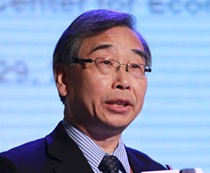-
首页
-
师资队伍展开 / 收起
 伍晓鹰
伍晓鹰 教授简介
教授简介北京大学国家发展研究院经济学教授。兼任日本一桥大学经济学特邀教授,及美国世界大型企业联合会(The Conference Board, TCB)高级学术顾问和TCB中国中心经济研究部主任。
主要研究领域包括经济增长、生产率及相关宏观经济测算,经济周期波动,以及以生产法PPP为基础的国际经济比较。是国际范围参与关于中国增长和生产率表现争论的主要学者。长期从事中国经济增长数据库的工作。开创了并继续发展《中国经济增长数据库》和《中国产业生产率数据库》。在宏观经济测算和国际比较领域与已故增长经济学家安格斯麦迪森教授(Angus Maddison)以及其创立的荷兰格罗宁根大学增长与发展中心有着紧密的工作关系,也是第一个将麦迪森有关世界经济长期增长和PPP国际比较研究系统地翻译和介绍给中国的学者,主持翻译了麦迪森的《世界经济千年史》、《世界经济千年统计》和《中国经济的长期表现》。现在参与TCB维护和发展麦迪森全球经济数据库(TED)工作中的中国部分工作,也担任国际麦迪森项目委员会委员。
早年曾在南开大学获得经济学学士和硕士学位。1988-93 年作为联合国DTCD 项目学者在新西兰Waikato 大学进行MPhil 及PhD 学习并获得博士学位,主修发展经济学和人口经济学。随后在澳大利亚阿德莱德大学经济系任博士后研究员。在1996-97年期间任澳大利亚外交与贸易部东亚分析中心任高级经济学家。离开澳大利亚后先后任教于香港理工大学和日本一桥大学。主持全球以哈佛大学为核心的KLEMS增长和生产率项目的中国部分,现担任亚洲KLEMS学会的第五届主席。曾经长期担任《收入与财富评论》等国际期刊的编辑委员会委员,也曾经被选为第28 届国际收入与财富学会理事会特别理事,2007年被世界银行的国际比较项目(ICP)的《国际比较项目季刊》邀请为进入编辑委员会。曾经或仍然担任一些国际、国家机构、政府或非政府组织研究项目的咨询专家,包括中国国家统计局、世界银行、亚洲发展银行、加拿大国际发展研究中心、阿根廷国家与社会研究中心、澳大利亚国际农业研究中心、美国世界大型企业联合会(TCB)及TCB中国中心、香港特区政府中央政策组(CPU)等等。
-
北大国发院研究教授
-
长期经济增长、生产率理论及宏观经济测算、劳动投入理论及劳动数量和报酬矩阵、资本投入理论及资本存量测算、短期经济波动、中国经济
-
长期经济增长、宏观经济测算
 学术论文
学术论文主要英文期刊文章:
· “How Does the Productivity and Economic Growth Performance of China and India Compare in the Post-Reform Era, 1981-2011?” with K.L. Krishna, Deb Kusum Das and Pilu Chandra Das, International Productivity Monitor, Number 33, Fall 2017
· “Sustainability of China’s Growth Model: A Productivity Perspective”, China & World Economy, 1–29, Vol. 24 (5): 1-29, 2016
· “Changes in the Occupational Structure of Chinese Workforce in the Course of China’s Industrialization and Urbanization 1912-1952”, The Economic Review, Institute of Economic Research, Hitotsubashi University, Vol. 67 (1): 47-68, 2016
· “Banking Structure and Industrial Growth: Evidence from China” with Justin Lin and Xifang Sun, Journal of Banking and Finance, Vol. 58: 131-143, 2015
· “Has China’s Fast Industrial Growth Been Efficient? ––An Industry-level Investigation with a Newly Constructed Data Set”, with Esther Y.P. Shea and Alice Shiu, Applied Economics, Vol. 47 (40): 4275-4298, 2015
· “The growth of ‘non-material services’ in China – Maddison’s ‘zero-labor-productivity-growth’ hypothesis revisited”, The Economic Review, Institute of Economic Research, Hitotsubashi University, Vol. 65 (3): 266-283, 2014
· “How fast has Chinese industry grown? – The upward bias hypothesis revisited”, China Economic Journal, Vol. 6 (2-3): 80-102, 2013
·“Measuring Industry Level Employment, Output and Labor Productivity in The Chinese Economy, 1987-2008”, The Economic Review, Institute of Economic Research, Hitotsubashi University, Vol. 64 (1): 42-61, 2013
· “Growth, Institutions, and Entrepreneurial Finance in China: A Survey”, with Carlo Milana, Strategic Change, Vol. 21 (3-4): 83-106, 2012
· “Deconstructing the BRICs:Structural Transformation and Aggregate Productivity Growth”, with Gaaitzen de Vries, Abdul A Erumban, Marcel P Timmer and Ilya B. Voskoboynikov, Journal of Comparative Economics, Vol. 40 (2): 211–227, 2012
· “The Real Growth of Chinese Industry Debate Revisited––Reconstructing China’s Industrial GDP in 1949-2008”, The Economic Review, Institute of Economic Research, Hitotsubashi University, Vol. 62 (3): 209-224, 2011
· “Comparative Output and Labor Productivity in Manufacturing Between China, Japan,Koreaand theUnited Statesfor ca. 1935 – A Production-Side PPP Approach”, with Tangjun Yuan and Kyoji Fukao, Explorations in Economic History, Vol. 47 (3), 2010
· “More Costly or More Productive? Measuring Changes in Competitiveness in Manufacturing Across Regions inChina”, with Vivian Chen and Bart van Ark, The Review of Income and Wealth, Series 55, Special Issue, 2009
· “Measuring Growth, Productivity, Income Distribution and Poverty in Transition Economies: Progress, Challenges and Prospects”, with Peter Saunders, The Review of Income and Wealth, Series 55, Special Issue, 2009
·“MeasuringChina’s Economic Performance”, with Angus Maddison, World Economics (by Economic Department, OxfordUniversity) Vol. 9 (2), April-June, 2008
· “Measuring Productivity Performance by Industry inChina1980-2005”, International Productivity Monitor, Fall, 2007: 55-74
· “The Chinese GDP Growth Rate Puzzle: How Fast Has the Chinese Economy Grown?”, Asian Economic Papers (MIT Press),2007, Vol. 6 (1): 1-24
· “Not all currency traders believe in unfettered free markets: Currency speculation and market intervention in Hong Kong,” The China Quarterly, June 2002, No.170: 441-458
· “How fast has Chinese industry grown? – Measuring the real output of Chinese industry”, The Review of Income and Wealth, 2002, Series 48 (2): 179-204
· China’s comparative labour productivity performance in manufacturing, 1952-1997: Catching up or falling behind? China Economic Review, 2001, Vol.12: 162-189
· MeasuringChina’s GDP level and growth performance: Alternative estimates and the implications, The Review of Income and Wealth, 2000, Series 46 (4): 475-499
· Reform ofChina’s foreign exchange regime and its implications in the light of the Asian financial crisis, MOCT-MOST Economic Policy in Transitional Economies, 1998, Vol.8 (3): 81-105
· Household income determination and regional income differential in ruralChina, with Xin Meng, Asia Economic Journal, 1998, Vol.12 (1): 65-88
· Economic reforms and endogenous technological change: The case of Chinese agriculture, with D.T. Nguyen, Asia-Pacific Economic Review, 1997, Vol.3 (1): 43-61
· Household grain consumption inChina: Effects of income, price and urbanisation, with Yanrui Wu, Asia Economic Journal, 1997, Vol.11 (3): 325-342
· The direct impact of relocation of farm labour on Chinese grain production, with Xin Meng,China Economic Review, 1996, Vol.7 (2): 105-122
· Do Chinese farmers reinvest in grain production? with Xin Meng,China Economic Review, 1996, Vol.7 (2): 123-134
· Rural-to-urban labour migration in post reformChina, with Li Zhou, Asian Pacific Economic Literature, 1996, Vol. 10 (2): 54-67
· Rural to Urban Migration in the People's Republic ofChina, TheChinaQuarterly, September 1994, No. 139: 670-698
· The "Real" Chinese Gross Domestic Product (GDP) In The Pre-Reform Period 1952-1977, Review of Income and Wealth, 1993, Series 39 (1): 63-87
最近主要工作论文:
· “Towards an Institutional Interpretation of TFP Changes in China”, Center for Economic Institutions Working Paper Series, WP2019-4, Institute of Economic Research, Hitotsubashi University 2019 (http://cei.ier.hit-u.ac.jp/English/publication/wp/wp-2019.html)
· “Accounting for the Role of Information and Communication Technology in China's Productivity Growth”, with David T. Liang, RIETI Discussion Papers 17-E-111, 2017 (https://www.rieti.go.jp/jp/publications/dp/17e111.pdf)
·“Accounting for the Sources of Growth in the Chinese Economy”, RIETI Discussion Papers 15-E-048, 2015 (http://www.rieti.go.jp/en/publications/summary/15040012.html)
· “Reconstructing China's Supply-Use and Input-Output Tables in Time Series”, with Keiko Ito, RIETI Discussion Papers 15-E-004, 2015 (http://www.rieti.go.jp/en/publications/summary/15010005.html)
· “Constructing Annual Employment and Compensation Matrices and Measuring Labor Input in China”, with Ximing Yue and George G. Zhang, RIETI Discussion Papers 15-E-005, 2015 (http://www.rieti.go.jp/en/publications/summary/15010006.html)
·“Constructing China's Net Capital Stock and Measuring Capital Services in China, 1980-2010”, RIETI Discussion Papers 15-E-006, 2015 (http://www.rieti.go.jp/en/publications/summary/15010007.html)
· “China’s growth and productivity performance debate revisited – Accounting for China’s sources of growth in 1949-2012”, The Conference Board Economics Working Papers, EPWP1401, 2014
·“Accounting for Labor Input in Chinese Industry, 1949-2009”, with Ximing Yue, RIETI Discussion Paper Series, 12-E-065, 2012 (http://www.rieti.go.jp/jp/publications/nts/12e065.html)
· “Measuring Gross Output, Value Added, Employment and Labor Productivity of the Chinese Economy at Industry Level, 1987-2008 – An Introduction to the CIP Database (Round 1.0)”, RIETI Discussion Paper Series, 12-E-066, 2012 (http://www.rieti.go.jp/jp/publications/nts/12e066.html)
 教授观点
教授观点-
【国发院学术下午茶系列讲座 】伍晓鹰:从全要素生产率表现看政策选择
2024-11-24 -
《经济观察报》伍晓鹰:从麦迪森《世界经济千年史》探索长期增长的密码
2023-01-13
国家发展研究院官方微信
Copyright© 1994-2012 北京大学 国家发展研究院 版权所有, 京ICP备05065075号-1
保留所有权利,不经允许请勿挪用



